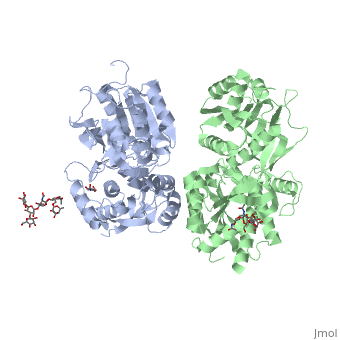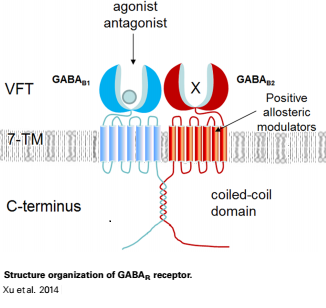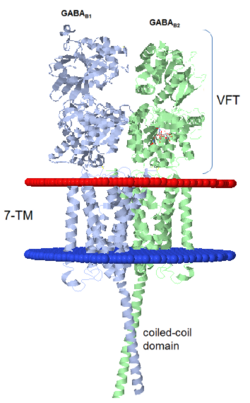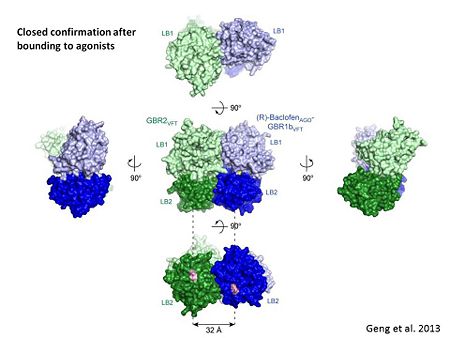User:Rana Saad/The human GABAb receptor
From Proteopedia
(Difference between revisions)
| Line 1: | Line 1: | ||
<StructureSection load='4mqe' size='340' side='right' caption='GABAb receptor' scene=''> | <StructureSection load='4mqe' size='340' side='right' caption='GABAb receptor' scene=''> | ||
[[Image:Gabab.xu2014.png |thumb|400px]] | [[Image:Gabab.xu2014.png |thumb|400px]] | ||
| - | |||
=='''''Introduction'''''== | =='''''Introduction'''''== | ||
===γ-Aminobutyric acid (GABA)=== | ===γ-Aminobutyric acid (GABA)=== | ||
| Line 19: | Line 18: | ||
All of the [http://en.wikipedia.org/wiki/Agonist agonists] and [http://en.wikipedia.org/wiki/Receptor_antagonist antagonists] bind the '''extracellular VFT module situated at the crevice between the LB1 and LB2 domains of the GBR1 subunit'''. | All of the [http://en.wikipedia.org/wiki/Agonist agonists] and [http://en.wikipedia.org/wiki/Receptor_antagonist antagonists] bind the '''extracellular VFT module situated at the crevice between the LB1 and LB2 domains of the GBR1 subunit'''. | ||
| - | Both lobes LB1 and LB2 resdues of GBR1 interact with the GABA<sub>B</sub> agonsits such as: [http://en.wikipedia.org/wiki/Gamma-Aminobutyric_acid GABA],[http://en.wikipedia.org/wiki/Baclofen baclofen]. as a results of this interacting '''closed conformation''' will be stabilized when <scene name='70/701448/Gaba_ligand/4'> GBR1 subunit bound to GABA</scene> or <scene name='70/701448/Baclofen/3'>bound to baclofen</scene> and other agonists. | + | Both lobes LB1 and LB2 resdues of GBR1 interact with the GABA<sub>B</sub> agonsits such as: [http://en.wikipedia.org/wiki/Gamma-Aminobutyric_acid GABA],[http://en.wikipedia.org/wiki/Baclofen baclofen]. as a results of this interacting '''closed conformation''' will be stabilized when <scene name='70/701448/Gaba_ligand/4'> GBR1 subunit bound to GABA</scene> (PDB 4MS3) or <scene name='70/701448/Baclofen/3'>bound to baclofen</scene> (PDB 4MS4) and other agonists. |
[[Image:GABAb bound to agonist.jpg|center|450px]] | [[Image:GABAb bound to agonist.jpg|center|450px]] | ||
GABA<sub>B</sub> antgonists such as: [http://en.wikipedia.org/wiki/Saclofen saclofen], [http://www.hellobio.com/cgp-46381.html CGP46381], [http://www.hellobio.com/phaclofen.html?picat=&q=phaclofen phaclofen], [http://www.hellobio.com/cgp-35348.html?picat=&q=CGP+35348 CGP35348] and [http://www.hellobio.com/cgp-54626-hydrochloride.html?picat=&q=CGP+54626 CGP54626], mostly intercat with LB1 resduses of GBR1. both ends of the antagonist bind the LB1, which produce '''open confirmation''' of GBR1. | GABA<sub>B</sub> antgonists such as: [http://en.wikipedia.org/wiki/Saclofen saclofen], [http://www.hellobio.com/cgp-46381.html CGP46381], [http://www.hellobio.com/phaclofen.html?picat=&q=phaclofen phaclofen], [http://www.hellobio.com/cgp-35348.html?picat=&q=CGP+35348 CGP35348] and [http://www.hellobio.com/cgp-54626-hydrochloride.html?picat=&q=CGP+54626 CGP54626], mostly intercat with LB1 resduses of GBR1. both ends of the antagonist bind the LB1, which produce '''open confirmation''' of GBR1. | ||
it is very easy to notice the '''open confirmation''' when : | it is very easy to notice the '''open confirmation''' when : | ||
| - | <scene name='70/701448/Saclofen_ant/2'>GBR1 subunit bound to saclofen</scene>. | + | <scene name='70/701448/Saclofen_ant/2'>GBR1 subunit bound to saclofen</scene> (PDB 4MQF). |
| - | <scene name='70/701448/Cgp46381_ant/2'>GBR1 subunit bound to CGP46381</scene>. | + | <scene name='70/701448/Cgp46381_ant/2'>GBR1 subunit bound to CGP46381</scene> (PDB 4MS1). |
| - | <scene name='70/701448/Phaclofen_ant/1'>GBR1 subunit bound to phaclofen</scene>. | + | <scene name='70/701448/Phaclofen_ant/1'>GBR1 subunit bound to phaclofen</scene> (PDB 4MRM). |
| - | <scene name='70/701448/Ant_cg835348/1'>GBR1 subunit bound to CGP35348</scene>. | + | <scene name='70/701448/Ant_cg835348/1'>GBR1 subunit bound to CGP35348</scene> (PDB 4MR8). |
| - | <scene name='70/701448/Ant_CGP54626/1'>GBR1 subunit bound to CGP54626</scene>. | + | <scene name='70/701448/Ant_CGP54626/1'>GBR1 subunit bound to CGP54626</scene> (PDB 4MR7). |
[[ Image:GABAb bound to antagonist.jpg|center|450px]] | [[ Image:GABAb bound to antagonist.jpg|center|450px]] | ||
=='''''Dimerization motif'''''== | =='''''Dimerization motif'''''== | ||
| - | When the GBR1 subunit is expressed alone, it is trapped in vesicles within the cell, whereas the GBR2 alone is expressed on the cell surface, but cannot bind GABA or activate G proteins. When both receptor subunits are expressed in the same cell, the receptors interact through <scene name='70/701448/C_termenal_coild_coil_domain/1'>coiled-coil domain</scene><ref>PMID:24778228</ref><ref>PMID:12209124</ref> in their carboxyl tails. They are then expressed on the cell surface, bind GABA and activate G proteins. | + | When the GBR1 subunit is expressed alone, it is trapped in vesicles within the cell, whereas the GBR2 alone is expressed on the cell surface, but cannot bind GABA or activate G proteins. When both receptor subunits are expressed in the same cell, the receptors interact through <scene name='70/701448/C_termenal_coild_coil_domain/1'>coiled-coil domain</scene><ref>PMID:24778228</ref><ref>PMID:12209124</ref> (PDB 4PAS) in their carboxyl tails. They are then expressed on the cell surface, bind GABA and activate G proteins. |
This domain is shaped by <scene name='70/701448/Coild-coil_domain/1'>polar interactions within the hydrophobic core</scene> and is stabilized by <scene name='70/701448/C_termenal_coild_coil_domain/3'>hydrogen-bonding interactions</scene><ref>PMID:24778228</ref>. | This domain is shaped by <scene name='70/701448/Coild-coil_domain/1'>polar interactions within the hydrophobic core</scene> and is stabilized by <scene name='70/701448/C_termenal_coild_coil_domain/3'>hydrogen-bonding interactions</scene><ref>PMID:24778228</ref>. | ||
Revision as of 20:49, 8 July 2015
| |||||||||||




